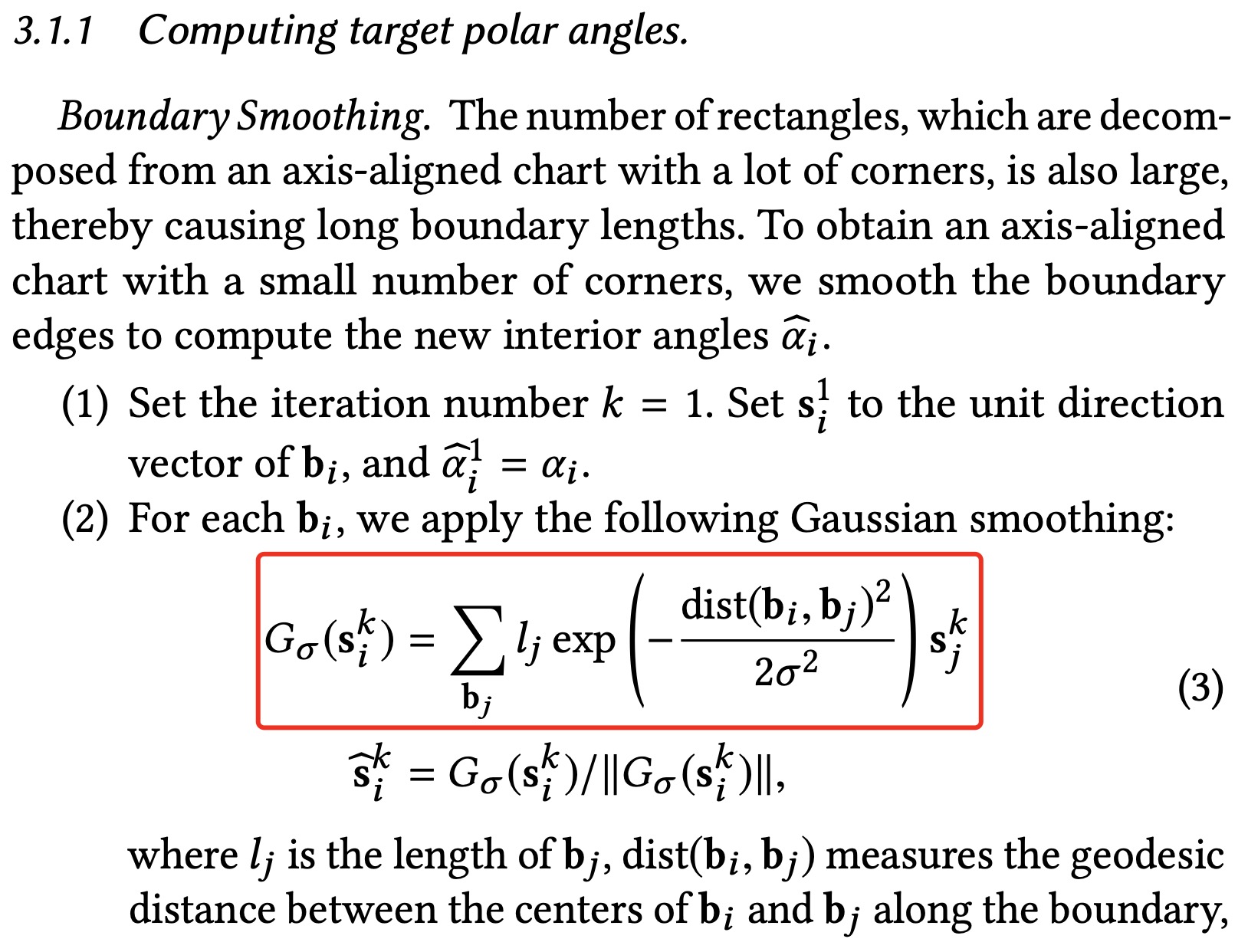An example from Atlas Refinement with Bounded Packing Efficiency Eq. 3
The original equation:

I❤️LA implementation:
`G_σ(s^k_i)` = ∑_j l_j exp(-dist(`bᵢ`, b_j)²/(2σ²)) `s^k`_j
where
l_j ∈ ℝ : the length of bj
dist: ℝ², ℝ² → ℝ : measures the geodesic distance
`bᵢ` ∈ ℝ²
b_j ∈ ℝ²
σ ∈ ℝ
`s^k`_j ∈ ℝ² : direction vectorI❤️LA compiled to C++/Eigen:
/*
`G_σ(s^k_i)` = ∑_j l_j exp(-dist(`bᵢ`, b_j)²/(2σ²)) `s^k`_j
where
l_j ∈ ℝ : the length of bj
dist: ℝ², ℝ² → ℝ : measures the geodesic distance
`bᵢ` ∈ ℝ²
b_j ∈ ℝ²
σ ∈ ℝ
`s^k`_j ∈ ℝ² : direction vector
*/
#include <Eigen/Core>
#include <Eigen/Dense>
#include <Eigen/Sparse>
#include <iostream>
#include <set>
struct atlas_refinement_3ResultType {
Eigen::Matrix<double, 2, 1> G_σ_left_parenthesis_s_circumflex_accent_k_i_right_parenthesis;
atlas_refinement_3ResultType(const Eigen::Matrix<double, 2, 1> & G_σ_left_parenthesis_s_circumflex_accent_k_i_right_parenthesis)
: G_σ_left_parenthesis_s_circumflex_accent_k_i_right_parenthesis(G_σ_left_parenthesis_s_circumflex_accent_k_i_right_parenthesis)
{}
};
/**
* atlas_refinement_3
*
* @param l the length of bj
* @param dist ℝ², ℝ² → ℝ : measures the geodesic distance
* @param s_circumflex_accent_k direction vector
* @return G_σ_left_parenthesis_s_circumflex_accent_k_i_right_parenthesis
*/
atlas_refinement_3ResultType atlas_refinement_3(
const std::vector<double> & l,
const std::function<double(Eigen::Matrix<double, 2, 1>, Eigen::Matrix<double, 2, 1>)> & dist,
const Eigen::Matrix<double, 2, 1> & bᵢ,
const std::vector<Eigen::Matrix<double, 2, 1>> & b,
const double & σ,
const std::vector<Eigen::Matrix<double, 2, 1>> & s_circumflex_accent_k)
{
const long dim_0 = l.size();
assert( b.size() == dim_0 );
assert( s_circumflex_accent_k.size() == dim_0 );
Eigen::MatrixXd sum_0 = Eigen::MatrixXd::Zero(2, 1);
for(int j=1; j<=s_circumflex_accent_k.size(); j++){
sum_0 += l.at(j-1) * exp(-pow(dist(bᵢ, b.at(j-1)), 2) / double((2 * pow(σ, 2)))) * s_circumflex_accent_k.at(j-1);
}
Eigen::Matrix<double, 2, 1> G_σ_left_parenthesis_s_circumflex_accent_k_i_right_parenthesis = sum_0;
return atlas_refinement_3ResultType(G_σ_left_parenthesis_s_circumflex_accent_k_i_right_parenthesis);
}
void generateRandomData(std::vector<double> & l,
std::function<double(Eigen::Matrix<double, 2, 1>, Eigen::Matrix<double, 2, 1>)> & dist,
Eigen::Matrix<double, 2, 1> & bᵢ,
std::vector<Eigen::Matrix<double, 2, 1>> & b,
double & σ,
std::vector<Eigen::Matrix<double, 2, 1>> & s_circumflex_accent_k)
{
σ = rand() % 10;
const int dim_0 = rand()%10;
l.resize(dim_0);
for(int i=0; i<dim_0; i++){
l[i] = rand() % 10;
}
dist = [](Eigen::Matrix<double, 2, 1>, Eigen::Matrix<double, 2, 1>)->double{
return rand() % 10;
};
bᵢ = Eigen::VectorXd::Random(2);
b.resize(dim_0);
for(int i=0; i<dim_0; i++){
b[i] = Eigen::VectorXd::Random(2);
}
s_circumflex_accent_k.resize(dim_0);
for(int i=0; i<dim_0; i++){
s_circumflex_accent_k[i] = Eigen::VectorXd::Random(2);
}
}
int main(int argc, char *argv[])
{
srand((int)time(NULL));
std::vector<double> l;
std::function<double(Eigen::Matrix<double, 2, 1>, Eigen::Matrix<double, 2, 1>)> dist;
Eigen::Matrix<double, 2, 1> bᵢ;
std::vector<Eigen::Matrix<double, 2, 1>> b;
double σ;
std::vector<Eigen::Matrix<double, 2, 1>> s_circumflex_accent_k;
generateRandomData(l, dist, bᵢ, b, σ, s_circumflex_accent_k);
atlas_refinement_3ResultType func_value = atlas_refinement_3(l, dist, bᵢ, b, σ, s_circumflex_accent_k);
std::cout<<"return value:\n"<<func_value.G_σ_left_parenthesis_s_circumflex_accent_k_i_right_parenthesis<<std::endl;
return 0;
}I❤️LA compiled to Python/NumPy/SciPy:
"""
`G_σ(s^k_i)` = ∑_j l_j exp(-dist(`bᵢ`, b_j)²/(2σ²)) `s^k`_j
where
l_j ∈ ℝ : the length of bj
dist: ℝ², ℝ² → ℝ : measures the geodesic distance
`bᵢ` ∈ ℝ²
b_j ∈ ℝ²
σ ∈ ℝ
`s^k`_j ∈ ℝ² : direction vector
"""
import numpy as np
import scipy
import scipy.linalg
from scipy import sparse
from scipy.integrate import quad
from scipy.optimize import minimize
class atlas_refinement_3ResultType:
def __init__( self, G_σ_left_parenthesis_s_circumflex_accent_k_i_right_parenthesis):
self.G_σ_left_parenthesis_s_circumflex_accent_k_i_right_parenthesis = G_σ_left_parenthesis_s_circumflex_accent_k_i_right_parenthesis
def atlas_refinement_3(l, dist, bᵢ, b, σ, s_circumflex_accent_k):
"""
:param :l : the length of bj
:param :dist : ℝ², ℝ² → ℝ : measures the geodesic distance
:param :s_circumflex_accent_k : direction vector
"""
l = np.asarray(l, dtype=np.float64)
bᵢ = np.asarray(bᵢ, dtype=np.float64)
b = np.asarray(b, dtype=np.float64)
s_circumflex_accent_k = np.asarray(s_circumflex_accent_k, dtype=np.float64)
dim_0 = l.shape[0]
assert l.shape == (dim_0,)
assert bᵢ.shape == (2,)
assert b.shape == (dim_0, 2, )
assert np.ndim(σ) == 0
assert s_circumflex_accent_k.shape == (dim_0, 2, )
sum_0 = np.zeros((2, ))
for j in range(1, len(s_circumflex_accent_k)+1):
sum_0 += l[j-1] * np.exp(-np.power(dist(bᵢ, b[j-1]), 2) / (2 * np.power(σ, 2))) * s_circumflex_accent_k[j-1]
G_σ_left_parenthesis_s_circumflex_accent_k_i_right_parenthesis = sum_0
return atlas_refinement_3ResultType(G_σ_left_parenthesis_s_circumflex_accent_k_i_right_parenthesis)
def generateRandomData():
σ = np.random.randn()
dim_0 = np.random.randint(10)
l = np.random.randn(dim_0)
def dist(p0, p1):
return np.random.randn()
bᵢ = np.random.randn(2)
b = np.random.randn(dim_0, 2, )
s_circumflex_accent_k = np.random.randn(dim_0, 2, )
return l, dist, bᵢ, b, σ, s_circumflex_accent_k
if __name__ == '__main__':
l, dist, bᵢ, b, σ, s_circumflex_accent_k = generateRandomData()
print("l:", l)
print("dist:", dist)
print("bᵢ:", bᵢ)
print("b:", b)
print("σ:", σ)
print("s_circumflex_accent_k:", s_circumflex_accent_k)
func_value = atlas_refinement_3(l, dist, bᵢ, b, σ, s_circumflex_accent_k)
print("return value: ", func_value.G_σ_left_parenthesis_s_circumflex_accent_k_i_right_parenthesis)I❤️LA compiled to MATLAB:
function output = atlas_refinement_3(l, dist, b_i, b, sigma, s_k)
% output = atlas_refinement_3(l, dist, `bᵢ`, b, σ, `s^k`)
%
% `G_σ(s^k_i)` = ∑_j l_j exp(-dist(`bᵢ`, b_j)²/(2σ²)) `s^k`_j
%
% where
% l_j ∈ ℝ : the length of bj
% dist: ℝ², ℝ² → ℝ : measures the geodesic distance
% `bᵢ` ∈ ℝ²
% b_j ∈ ℝ²
% σ ∈ ℝ
% `s^k`_j ∈ ℝ² : direction vector
if nargin==0
warning('generating random input data');
[l, dist, b_i, b, sigma, s_k] = generateRandomData();
end
function [l, dist, b_i, b, sigma, s_k] = generateRandomData()
sigma = randn();
dim_0 = randi(10);
l = randn(dim_0,1);
dist = @distFunc;
rseed = randi(2^32);
function tmp = distFunc(p0, p1)
rng(rseed);
tmp = randn();
end
b_i = randn(2,1);
b = randn(dim_0,2);
s_k = randn(dim_0,2);
end
l = reshape(l,[],1);
b_i = reshape(b_i,[],1);
dim_0 = size(l, 1);
assert( size(l,1) == dim_0 );
assert( numel(b_i) == 2 );
assert( isequal(size(b), [dim_0, 2]) );
assert(numel(sigma) == 1);
assert( isequal(size(s_k), [dim_0, 2]) );
sum_0 = zeros(2,1);
for j = 1:size(s_k, 1)
sum_0 = sum_0 + l(j) * exp(-dist(b_i, b(j,:)').^2 / (2 * sigma.^2)) * s_k(j,:)';
end
G_sigma_s_k_i = sum_0;
output.G_sigma_s_k_i = G_sigma_s_k_i;
end
I❤️LA compiled to LaTeX:
\documentclass[12pt]{article}
\usepackage{mathdots}
\usepackage[bb=boondox]{mathalfa}
\usepackage{mathtools}
\usepackage{amssymb}
\usepackage{libertine}
\DeclareMathOperator*{\argmax}{arg\,max}
\DeclareMathOperator*{\argmin}{arg\,min}
\usepackage[paperheight=8in,paperwidth=4in,margin=.3in,heightrounded]{geometry}
\let\originalleft\left
\let\originalright\right
\renewcommand{\left}{\mathopen{}\mathclose\bgroup\originalleft}
\renewcommand{\right}{\aftergroup\egroup\originalright}
\begin{document}
\begin{center}
\resizebox{\textwidth}{!}
{
\begin{minipage}[c]{\textwidth}
\begin{align*}
\textit{G\_σ(s\^k\_i)} & = \sum_\mathit{j} \mathit{l}_{ \mathit{j} }exp\left( -\frac{{\mathit{dist}\left( \textit{b\textsubscript{i}},\mathit{b}_{ \mathit{j} } \right)}^{2}}{2{\mathit{σ}}^{2}} \right)\textit{s\^k}_{ \mathit{j} } \\
\intertext{where}
\mathit{l}_{\mathit{j}} & \in \mathbb{R} \text{ the length of bj} \\
\mathit{dist} & \in \mathbb{R}^{ 2},\mathbb{R}^{ 2}\rightarrow \mathbb{R} \text{ measures the geodesic distance } \\
\textit{b\textsubscript{i}} & \in \mathbb{R}^{ 2} \\
\mathit{b}_{\mathit{j}} & \in \mathbb{R}^{ 2} \\
\mathit{σ} & \in \mathbb{R} \\
\textit{s\^k}_{\mathit{j}} & \in \mathbb{R}^{ 2} \text{ direction vector} \\
\\
\end{align*}
\end{minipage}
}
\end{center}
\end{document}
I❤️LA LaTeX output: